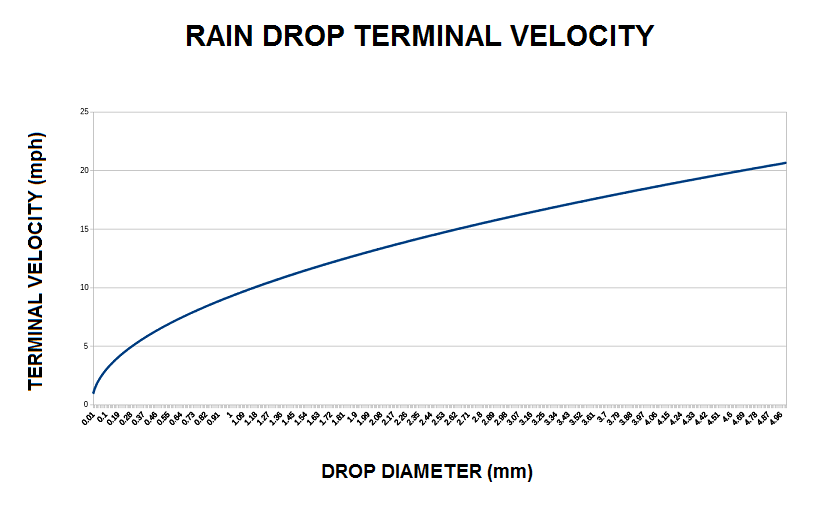.:: Rain Drop Terminal Velocity ::.
Finding out the maximum speed of a rain drop given it's size
This program produces multiple rain drop simulations across a domain of possible rain drop diameters. The largest possible rain drop is 5mm diameter. This is because at larger sizes the drops break apart into smaller parts.
Here is a chart I made using the data from my simulation (terminal velocity / diameter of rain drop)

1 2 3 4 5 6 7 8 9 10 11 12 13 14 15 16 17 18 19 20 21 22 23 24 25 26 27 28 29 30 31 32 33 34 35 36 37 38 39 40 41 42 43 44 45 46 47 48 49 50 51 52 53 54 55 56 57 58 59 60 61 62 | using System; using System.Collections.Generic; using System.Linq; using System.Text; using System.Threading.Tasks; using System.IO; namespace RainDrop001 { class Program { static double Drag(double velocity, double diameter) // COMPUTE AIR DRAG { double area = Math.PI * Math.Pow(diameter / 2, 2); //F = .5 * density_of_air * velocity^2 * drag_coef * area return .5 * 1.225 * Math.Pow(velocity, 2) * .47 * area * Math.Sign(velocity); } static void Main(string[] args) { for (double d = 0.01; d < 5; d += .01) { double height = 500; // initial height double diam = d * 0.001; // diameter of rain drop double mass = ((4 / 3) * Math.PI * Math.Pow(diam / 2, 3)) * 1000; double v = 0; // initial velocity double dt = 0.0001; // delta time while (height > 0) { double a = (-Drag(v, diam) / mass) - 9.8; // calculate acceleration v += a * dt; height += v * dt; } //File.AppendAllText(@"C:\Users\Rostislav\Desktop\raindrop.txt", d.ToString() + ", " + Math.Round(-v * 2.23694, 2).ToString() + Environment.NewLine); Console.ForegroundColor = ConsoleColor.Green; Console.WriteLine("DIAMETER (mm): " + d); Console.WriteLine("SPEED (mph): " + Math.Round(v * 2.23694, 2)); Console.WriteLine("ENERGY (Joules): " + .5 * mass * Math.Pow(v,2)); Console.WriteLine(); } Console.WriteLine("DONE."); Console.ReadLine(); } } } |